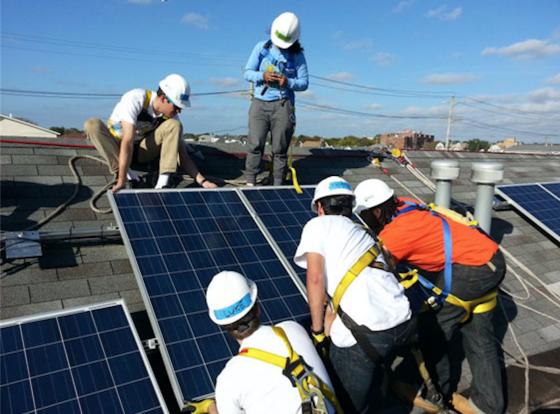Green Building Community
Social Justice and the Solar Industry - Starting to Address the Elephant in the Room
Posted by: PatPrince317 // Lifelong Learner and Green Energy Aficionado

If states and city governments are serious about meeting their clean energy benchmarks, they must do better at reaching minority and low-income communities. States need to take action whether or not the solar industry acknowledges the elephant in the room. In the solar industry, both in jobs andin terms of installed solar, minority populations are not fully and fairly represented, not even close.
As detailed in Andrea Hsu's reporting for npr, "Stepping Into The Sun: A Mission To Bring Solar Energy To Communities Of Color," UC Berkeley researcher Deborah Sunter analyzed google Project Sunroof rooftop solar data in 2016 and found significant disparities in rooftop solar, based on race and ethnicity. Census tracts where African Americans and Latinos made up at least 50% of the population had strikingly less rooftop solar than white-majority census tracts and even census tracts with no racial or ethnic majority:
"Accounting for household income, black- and Hispanic-majority census tracts had installed 69% and 30% less rooftop solar compared with no-majority census tracts, while white-majority census tracts had installed 21% more.
Accounting for homeownership, black- and Hispanic-majority census tracts had installed 61% and 45% less solar compared with no-majority census tracts, while white-majority census tracts had installed 37% more."
These numbers suggest a significant environmental justice issue in this circumstance, intentional or not. Many minority residents face higher energy costs as a percentage of their income, and many also live in older buildings, which are less likely to be efficient. It's clearly critical for social equity reasons and for environmental impact to bring more awareness and more solar and other renewable energy resources to these negihborhoods.
The article introduces some potential reasons for the solar disparity in minority neighborhoods. These are the start of an important conversation, and should be explored further and investigated in further detail. Two top reasons include that people in minority communities might not have historically seen as much solar around them, which is often a way that interest in solar spreads, and similatly that people licing in these same communities may not have known someone working in the industry, which relates to both installed solar amounts, renewable energy education/awarness generally, and also the procivlity to enter a solar-related career.
Hsu also details the story of Tennessean solar installer Jason Carney, who noticed a 0% count of African Americans in the solar industry in Tennessee in 2015. This seemed strange to Mr. Carney, as he was an African American solar installer, in Tennessee. But he agreed the number wasn't very far off, as he was often the only person or maybe one of two people of color at larger gatherings. Indeed, the 2018 Solar Jobs Census, published by The Solar Foundation recorded that 73.3% of all solar industry workers were white. Mr. Carney was also the only black person he was aware of with installed solar. Hopefully in a sign of progress to come, Mr. Carney has been working to introduce solar to new and underserved communities, through the Southern Alliance for Clean Energy and through his own consulting business.
The good news is that some states are making progress toward increassing solar for low to moderate-income populations, like New York and California. Even South Carolina is trying to remove the red tape.
- In New York: OYA Solar and Crauderueff & Associates have partnered to develop rooftop solar and storage for the more than 2,500 regulated affordable housing buildings in New York City.
- California: The California Department of Community Services and Development (CSD) granted $4.4 million to GRID Alternatives to build two community solar projects in Contra Costa and Riverside counties, an effort which is also part of CSD’s Low-Income Weatherization Program.
- South Carolina: South Carolina’s new "Energy Freedom Act" completely overhauls the state’s solar policy and aims to reduce barriers to solar and solar storage.
For more information:
Andrew Hsu’s npr article:
https://www.npr.org/2019/07/23/741952615/stepping-into-the-sun-a-mission-to-bring-solar-energy-to-communities-of-color
To read more about Mr. Jason Carney’s experiences in and with the solar industry, his own saga to install solar on his own house, and his hope for a more equitable system going forward:
https://cleanenergy.org/blog/my-story-jason-carney-solarpv/
To read the 2018 Solar Jobs Census, published by The Solar Foundation:
(Next release: early 2020)
https://www.thesolarfoundation.org/solar-jobs-census/factsheets-2018/
Solar Census Information by State:
https://www.thesolarfoundation.org/solar-jobs-census/factsheets-2018/
Please be kind and respectful!
Please make sure to be respectful of the organizations and companies, and other Rate It Green members that make up our community. We welcome praise and advice and even criticism but all posted content and ratings should be constructive in nature. For guidance on what constitutes suitable content on the Rate It Green site, please refer to the User Agreement and Site Rules.
The opinions, comments, ratings and all content posted by member on the Rate It Green website are the comments and opinions of the individual members who posts them only and do not necessarily reflect the views or policies or policies of Rate It Green. Rate It Green Team Members will monitor posted content for unsuitable content, but we also ask for the participation of community members in helping to keep the site a comfortable and open public forum of ideas. Please email all questions and concerns to admin@rateitgreen.com

